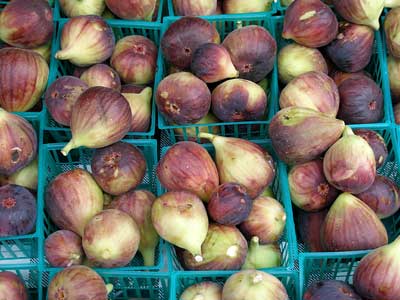originally indigenous to the Middle-east, the fig is a fibrous fruit of soft, thin skin, ranging in color from pale green to scarlet, purple, and deep brown. It grows on a small tree which has naturalized to many places around the globe. It ripens late at the end of summer and its ripeness is indicated by a sticky residue at its wide base. The name "fig" derives from the ancient Hebrew word," feg" and the Latin, ficus. Figs are dried, preserved in compotes, or eaten fresh. The seeds may be pulled away or eaten with the fruit.To eat, the best thing to do is to squeeze the fruit slightly together at the rounded bottom, using the thumb and forefinger of both hands, and then pull it apart, revealing the extraordinary, glistening, pinkish-red interior. While it is acceptable to eat figs without utensils, the more dainty way is to use a knife and fork. DH Lawrence describes it thus: "The proper way to eat a fig, in society is to split it in four, holding it by the stump and open it, so that it is a glittering, rosy, moist, honied, heavy-petalled four-petalled flower. Then you throw away the skin which is just like a four-sepalled calyx after you have taken off the blossom with your lips. But the vulgar way is just to put your mouth to the crack, and take out the flesh in one bite." Lawrence was rather taken with figs, and with rotting medlars.
